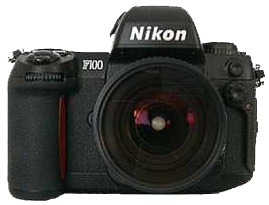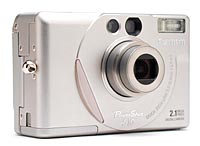spiffy stuff
I put the Noctilux to good use in late February. Click on the thumbnail above.
I'd planned to just take a group photo of the crew but getting people to pose for me seemed stressful.
I decided to go out on the coach's launch instead. Of course, at that time of year in Seattle,
the sun doesn't rise until around 7am, so photographing anything was a challenge. I used Kodak
Ektachrome P1600 (color) and Delta 3200 (B&W) film with the M6 and it's Noctilux and the
F100 and a couple of f/2.8 zooms. After dawn, I used Ektachrome 100S, which along with 100VS,
is the film I use most. I was quite happy with the results. Obviously, there's very noticable grain;
with other fast slide film, Kodak usually says "hey, it's fast film but, honest, there's not much grain"
but not here. For granular artistic applications is their description of P1600 (not too sure about the "artistic" bit).
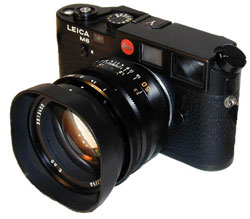
Once again, it's amusing to read back on what I've written in this section.
It now seems odd that I was worried about using a lot of film with the F100. Since I got the Leica
back in September '00, I've probably used (ok, "shot"...whatever) at least four rolls of film every week.
I've discovered that processing film is like doing laundry - do it regularly and it's no hassle, soothing even
(maybe that's a stretch); let it accumulate and it's very, very boring. The Leica is small enough
that I carry it almost everywhere. It's certainly my default camera. I still use the F100 and D1 a lot
- there are many occasions where they are the best or only choice - but the Leica is always with me.
Ok, enough preamble.
As I mention below, I got the Leica with a 35mm f/1.4 lens. This is an excellent all-round lens,
although it is a little bigger than Leica's slower lenses. "Slower" means a smaller aperture - the "f" setting.
Aparture is how much light is getting to the film; shutter speed is how long you're letting light onto the film.
Oh, here's something that's confusing: a smaller f number represents a larger aperture. Fast lenses are
expensive, and long, fast lenses are very expensive. Here's a good example: Nikon has a 300mm f/4 and a
300mm f/2.8. Apart from the speed difference, they are very similar, quality-wise. The f/4 is about $1500 but
the f/2.8 is $5500. If you've been to any professional sports games, you would have seen one of these lenses.
I borrowed one recently and had a ball. I felt like Jimmy Stewart in "Rear Window" (without the broken leg!).
End of Photography 101. For more info, I'd suggest the "National Geographic Field Guide to Photography".
Anyway, as I said above, the 35mm f/1.4 (or 35mm Summilux in Leica terminology) is a great lens - a fast,
wide angle. I live in an interesting neighborhood that gets more interesting after dark and I realized last week
that almost all my photos are taken at night, so I got a new lens. It's a 50mm f/1.0. If you're not familiar with
aperture numbers, f/1.4 to f/1.4 may not seem like a big difference. Actually, it is: that jump is refered to
as a "stop" and each stop changes the light by a factor of 2. So, using the f/1.0 lets double the light of the
f/1.4 get to the film. It's really an amazing difference. There are some photos I took with this lens
on the December '00 page (go to new).
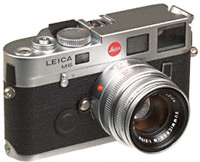
Anybody reading this page (and I don't think anyone does - tell me if I'm wrong) must think I have
multiple personality disorder. If you scroll down, it seems like I've changed my mind about digital vs. film cameras
a couple of times. However, it's not really true; I like them both. The D1 has all the advantages of the F100
(further below) and they use the same lenses. However, both cameras are pretty large and really obvious.
I mostly take photos of people and I thought it'd be nice to have something that was less obtrusive.
The camera store I got the Nikons from also sells Leica equipment. I played with one a couple of times
but it wasn't until I started a black and white photography class that I appreciated it. The Leica M6 is
very simple; film speed, shutter speed, aperture and that's it. It's small and very quiet and, best of all,
doesn't look like anything special. I've taken many photos that I wouldn't have got with either of the Nikons.
Of course, the reverse is also true, so I'm lucky to have both. Dropping into photo techno-speak, I'm using a
35mm/f1.4 on the Leica; the perfect lens for photos in dark bars! There are two great Leica resources on the web:
photo.net's Leica section and the Leica Papers page.
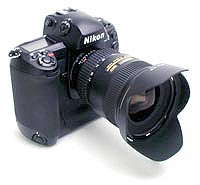
I've been using the F100 for a month or so now and although great, it's also been sort of a drag.
Film is expensive to get developed and after getting several rolls destroyed, I'm wary of using cheap-o labs.
I'm used to taking hundred of photos with a digital camera and having a dozen or so that are good -
an expensive proposition with film. To add insult to injury, almost all my photos end up on the web,
so I don't even want prints and scanning is real hassle. But an SLR with a real lens is the way to go.
The Nikon D1 seems to be the best of both worlds. It's bigger and heavier than the F100
(similar to the F5 ) but otherwise behaves just like a regular SLR. Almost all news photographers
now use either a D1 or the Kodak equivalent; these were taken with the D1.
Great for Angus-on-the-run shots, the D1 will take a burst of 21 images at 4.5fps.
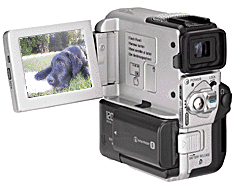
More of the same.
Below I say that the PC100 "takes decent still photos". Unfortunately, this didn't really
turn out to be the case. The 1152 x 882 pixel stills from the PC100 are ok but they're
not close to the quality of the Canon S10. Also, the Sony doesn't have an on-board flash.
I wasn't too worried about this but when Sony announced the PC5, I decided to get one.
Now, before you say "Are you crazy?!", there was already a chap at Adobe who wanted
to buy my PC100 for the same price as a new PC5. So, it was just a swap. You can't see it in
the photo above but the PC5 is much smaller than the PC100. This is a good thing as it means
I'm more likely to carry the camera with me. Here are some photos (link removed 2007) of the PC100 and
the PC5 side-by-side. Amazing. The PC5 is small enough that there isn't room for controls;
a touch screen is used to manage the camera and it works pretty well.
Sony's consumer products like the PC5 are impressive but their Professional equipment
is amazing. After spending way too much time browsing their maze-of-a-website,
I ordered a miniDV deck and a 14" monitor.
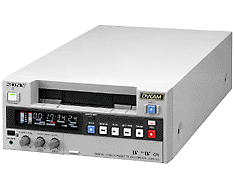
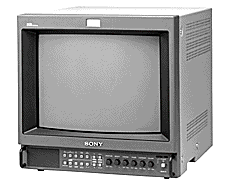
I had this great theory that buying an external DV deck would save my little camera
from wear-and-tear. Unfortunately, this theory has hopeless economics: it'd be much cheaper
to wear out the camera, toss it in the trash and buy a new one. Or, to just buy a second camera
and use it as a deck. I knew this but made the mistake of playing with a miniDV deck - the Sony DSR-20 -
that we have in Adobe's tech support department. After using a consumer DV device, the DSR-20
is a joy. Every operation is super-fast and feels very solid (not sure how to define that better).
The 14" monitor I bought is a Sony PVM-14M2U. If you're come this far, you probably already
know what a monitor is - in the video context - but, basically, it's a high quality TV screen
for viewing video. It has higher resolution that a normal TV (good for viewing DV video) and has
better color. Ironically, it lacks a TV tuner; plenty of places to plug video sources into
(a DVD player, for example) but no way to watch "Wheel of Fortune" out of the box. Darn.
Getting away from all the digital stuff, I just got a Nikon F100. It's Nikon's most recent
35mm F-series camera. The F5 is it's big brother but I've used one of these and it is much larger and
more expensive than the F100. After using digital cameras, it's been nice to use a film camera again.
None of the instant gratification of digital, of course, but there are big upsides. Being an SLR, the image through
the viewfinder is wonderful. Shutter release is almost instantaneous (a big failing of current digital cameras)
and very fast: switch to "Continuous" and the F100 will take five photos each second. I have a great sequence
of Angus racing towards me; when I get it developed, you'll see it on New. Like any F-series, the F100 comes
without a lens; I got a 28-200mm F3.5/5.6D IF AF Zoom-Nikkor (quite the mouthful). It's a big, squat thing
that gives both a wide-angle and telephoto lens in one. At the next regatta, it'll be nice to photograph races
and actually have the boat fill most of the frame. Lastly, the camera's autofocus is very fast and
like the Sony Pro equipment, it and everything else about the camera feels very solid.
Now I'm going to take a class to learn how to use it all!
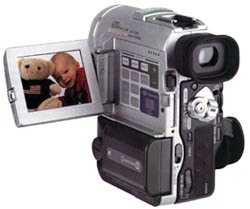
Mainly for making videos of Angus (my black lab), I decided to get a digital video camera.
I got a Sony DCR-PC100. It's very small and takes decent still photos.
Adobe makes great video editing software - Premiere and After Effects -
and I'm using these plus a product named Media Cleaner to make videos for dingoboy.com.
I'm using a Canopus DVRaptor card to get the video onto my computer
and an IBM 75Gb hard drive to store everything. It's all very good fun.
As I said below "I'm sure there will be a better model in a few months".
I was right! The CoolPix is great but is limited by no USB connection and no Compact Flash II.
Actually, even a bigger CF card wouldn't really help 'cause of the slow serial connection.
I bought the Canon s10 mainly for a trip to Australia. It's been a great camera, especially when
combined with the IBM Microdrive. The only problem is that it's battery life in really cold weather (-10C)
is pretty terrible: only a couple of minutes. Keeping the battery warm helps.
Read about the s10 here and feel free ask me questions.
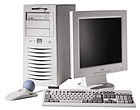
As I said below #2: "by far the nicest PC I've ever used".
I was writing about the at-the-time new Dell Workstation 410
I still use that computer at work and still love it. With the digital camera(s) and web server,
I'm updating my web site much more often, so I decided it was time to get a computer at home.
Not an easy choice. I was tempted to get a Dimension (Dell's standard home model) but ended up with
a pretty fancy Workstation 420. I decided I'd rather get something that I'll keep for a few years.
Read about it here. It's a dual- processor 733Mhz Pentium III with 512Mb RAM and
a couple of Ultra/160 SCSI hard drives. It's swell. And I'm glad I didn't have to pay for it.
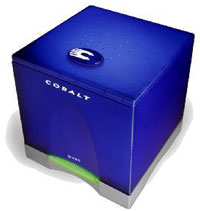
Speaking of swell, this is a great web server.
It's a Colbalt Qube2 and is an Internet appliance.
In this case, that means that it does a bunch of Internet-related stuff
with almost no configuration. Plug it in, give it an IP address via buttons on the back
then configure everything else via a web browser.
Underneath the cool blue cover is a MIPS processor running Linux.
Read more about it here.
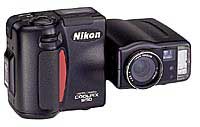
Real film is great but it's kind of a hassle to get developed and scanned.
After much stalling, I finally bought a digital camera. I'm sure there will be a better model in a few months,
but right now, the Nikon Coolpix 950 seems like a good choice:
1600 x 1200 resolution and image quality that you'd expect from Nikon.
When researching digital cameras, I found a great resource: photo.askey.net.
A well as a bunch of stuff about my camera, they have a great review of the camera I'd buy
if I had a spare $16000 (well, if I had a spare $16000 that I had to spend on a camera).

I'm finally going to learn more UNIX ('though that's not entirely my own choice),
so I got a Sun Ultra 10. It seems quite zippy but not as fast as the 400Mhz Dell Workstation
(by far the nicest PC I've ever used). Speaking of the Dell, I'm trying out a new video card:
the Matrox Millenium G200. It's got great 2D performance and is supposedly pretty good at 3D. We'll see.
Small-ish Toys of Summer '98
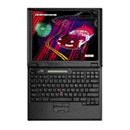
Not small enough but they never are. For my new job at Adobe, I ordered (among other things)
a ThinkPad 600. It arrived but was literally run over by the FedEx truck! How's that for being
born under a bad sign? Instead of waiting 6 weeks for a replacement, I decided to just get another 770.
The new model is a 770E with a DVD drive. Watching movies on the 14.1" screen is a hoot.
As for the Newton (see below), I returned it, deciding that I didn't really need to read email on the bus.
Also, it had terrible integration with the PC and was much bigger than my Pilot
Speaking of Apple, I feel guility that I didn't order a Macintosh for my new job. In fact, I didn't even consider it.
Probably should have: the 300Mhz G3 is pretty cool and Apple seem to have their act together.
Big Toys of Summer '97
So far, the best toy of all.
Jim says that I'm finally an American 'cause I have a car
and license. It's ironic that 0.4% of this car is from the US.
Click on the badge to go to my Land Rover page.
Toys of Spring
I'm really not too sure about this new toy: a MessagePad 2000.
Apple is really pretty hopeless and the MP2K has reinforced that opinion.
Not that it isn't cool; it's just that it could've been much better.
Hardware-wise it's very impressive & that's why I'm keeping it
but it's lacking PC & Mac apps that duplicate the built-in apps
(the PalmPilot does this much better).
Fortunately, the combination of the MP2K and a
Ricochet wireless modem
works incredibly well and enables me to web surf and
collect email on the way to work. The MP2K even supports
SecureID authentication, which Adobe uses to protect our network.
The bottom line about the MessagePad is that it's
far better than previous versions but I'm still carrying my Pilot
(a nice new Professional model with the backlighting).
Not a toy but still a lot of fun:
This machine should be predicting the weather or something.
It's a quad processor, 466Mhz 21164 AlphaServer 4100 with
2Gb RAM (yep) and 20Gb of storage.
And it's in my cube.
I love my job!
Right now, it's running a new Adobe PostScrip RIP and a trapping engine.
It's also running my own personal Microsoft Exchange 5.0 server.
After using primitive SMTP/POP3 mail, Exchange is a real step up.
Being able to check email via a web browser is very handy.
Toys of the New Year '97
It's not hard for me to justify some new toy; there's just two criteria:
small and hi-tech.
That explains the most recent purchases - a handheld GPS and a Canon Elph.
"So, what are you actually going to use it for?", asks my pal Elena.
Well, I guess she just doesn't see the attraction.
(The funny thing is that fellow Adobeing geeks didn't even think to ask - they understand).
Developed to more accurately nuke the crap out of the Ruskies
(specifically: to guide Pershing II tactical nuclear missiles to Russian ICBM silos in Western Europe),
the Global Positioning System can determine position, accurate within a couple of feet,
anywhere in the world. I have a pile of info and good links to GPS sites, but the best place to
start is the trusty FAQ. I've just acquired a new handheld Garmin 12XL GPS, pictured above.
It's especially spiffy 'cause it's really small (criteria one) and tracks 12 satellites - instead of the usual 8 -
to get a position (criteria two). If you're interested in getting one, contact CommSystems Intermountion.
They're very knowledgeable and won't try to sell you something you don't need.
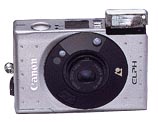
This little puppy is Canon's smallest camera (criteria one) and
uses the new Advanced Photo System (criteria... well, you get the idea).
When I was in Australia, I was out shopping for a video camera with my brother Terry
and happened to see the Elph on display. Doh! Stupid to buy a camera in Australia
(let alone not to buy it duty-free) but I'm glad I did anyway. Apart from the size
and new film type, it's nicest feature is the aluminum case; feels very well made.
[Update: Canon has released a couple of new Elph models; see them at the link above]
Neat-o Intel customers:
Intergraph Computer Systems, NetFRAME
Intergraph make the most impressive Intel-based systems around.
They've just released a bunch of models based on the Pentium Pro.
(Much as he wished for it, Dingo Boy didn't get a TDZ-600
for his birthday. Doh!) If you want the fastest workstation for Photosho
(and most other things) Intergraph are the people to see.
DV magazine think that the TDZ's are superior to those expensive, purple boxes from SGI.
[Update: I think that Dell's Workstation 610 is now the best]
NetFRAME also make Intel based systems
but they're a little more expensive:
they are dedicated file servers for NetWare and NT.
The thing I like about NetFRAME is their appearance.
Their design philosphy is:
"These machines cost a butt-load of money;
we better make sure they look cool"
And they do: black buttons on a black background with black text.
[Update: Micron bought NetFRAME and their servers don't look quite so cool anymore]
Alta Vista
DEC seems to have a knack for making wicked technology that can't be sold.
It's really too bad 'cause the Alpha processor is
AMAZING
I had one on loan for a while: 300Mhz 21164. Eek!
For reference, if you had a spare 40 mil and decided to buy a
Cray T3E (I prefer the liquid cooled model), it'd come with 2048 Alpha 21164's.
Speaking of supercomputers, there's a great article in Upside about their demise.
But back to the story: If you haven't already, check out DEC's
Alta Vista search engine.
Among other cool toys, it's powered by a 10 processor AlphaServer 8400 with 6Gb of RAM
HOLY CRAP!

